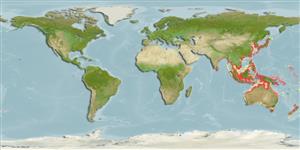Common names from other countries
Environment: milieu / climate zone / depth range / distribution range
Ecologie
Benthopelagisch; diepteverspreiding 0 - 50 m (Ref. 125642). Tropical, preferred 24°C (Ref. 107945)
Indo-West Pacific.
Length at first maturity / Size / Gewicht / Leeftijd
Maturity: Lm 13.1 range ? - ? cm Max length : 15.9 cm CW mannelijk/geslacht niet bekend; (Ref. 125642)
Carapace tough to granulose, regions discernible; front with 3 acutely triangular teeth; 9 teeth on each anterolateral margin, the last tooth much larger than preceding teeth. Larger chela with conical tooth at base of fingers; pollex ridged. Color: carapace dull green to brown.
Minimum depth assumed from its ecology. Shallow waters up to depths of 50 m. Inhabits sandy to sandy-muddy substrates (Ref. 343). Benthopelagic predator, feeding mainly on bivalves (Lamellibranchia), benthic crustaceans, fishes and cephalopods (Ref. 117071).
Members of the order Decapoda are mostly gonochoric. Mating behavior: Precopulatory courtship ritual is common (through olfactory and tactile cues); usually indirect sperm transfer.
Ng, P.K.L. 1998. (Ref. 343)
Status op de Rode Lijst van het IUCN (Ref. 130435)
Status bij CITES (Ref. 108899)
Not Evaluated
Not Evaluated
Gevaarlijk voor mensen
Harmless
Gebruik door de mens
Visserij: commercieel
FAO - Aquacultuur: production; Visserij: landings, soortsprofiel | FishSource | Sea Around Us
Tools
Internet-bronnen
Estimates based on models
Preferred temperature
(Ref.
115969): 13.8 - 29.1, mean 28 (based on 1586 cells).
Weerstandsvermogen
Hoog, minimale populatieverdubbelingstijd minder dan 15 maanden (K=0.44-1.76).
Prior r = 1.19, 95% CL = 0.79 - 1.79, Based on 2 data-limited stock assessments.
Kwetsbaarheid
Low vulnerability (10 of 100).
